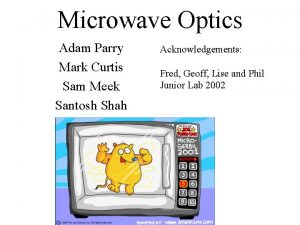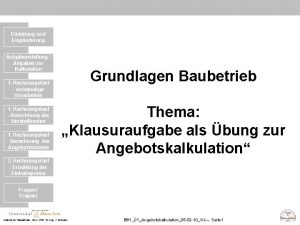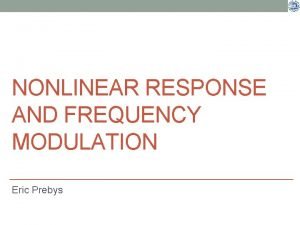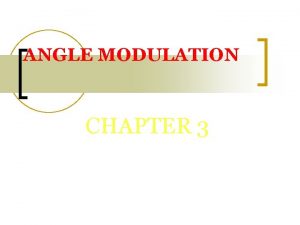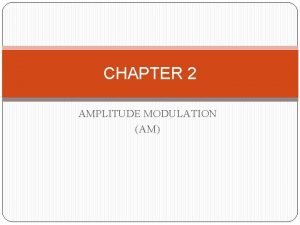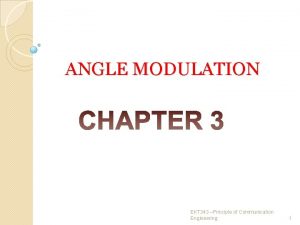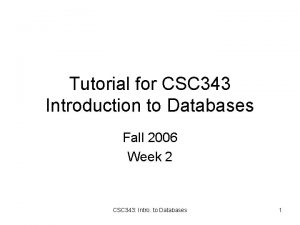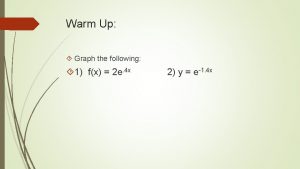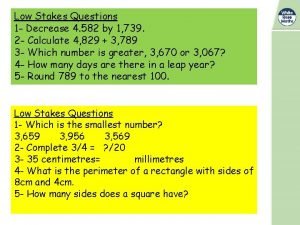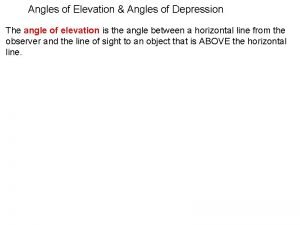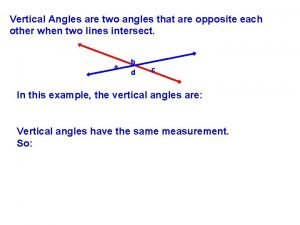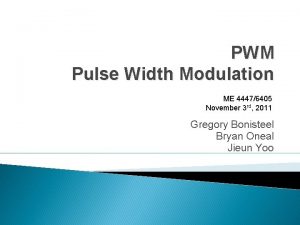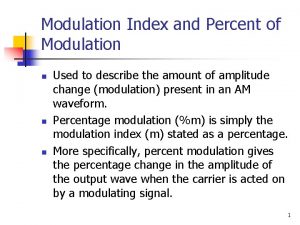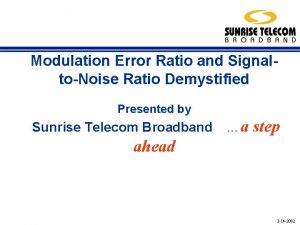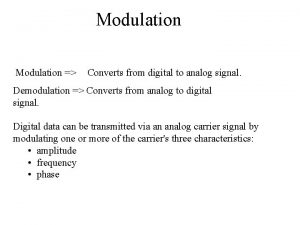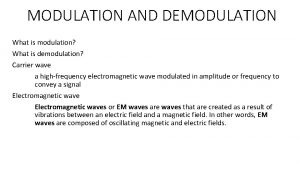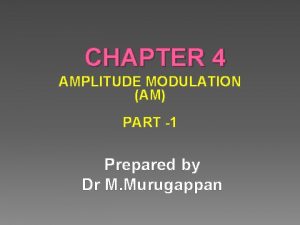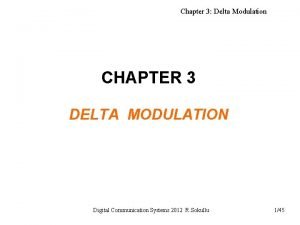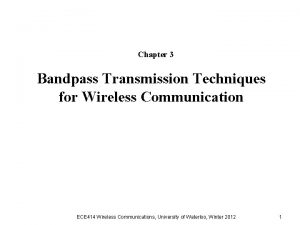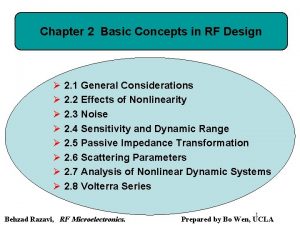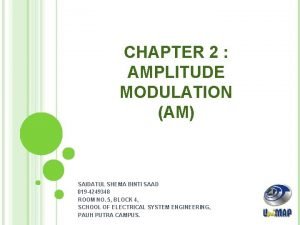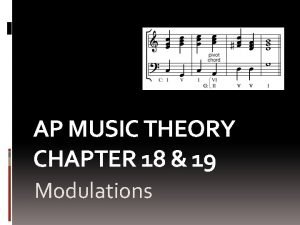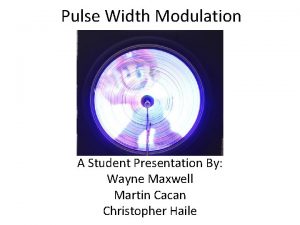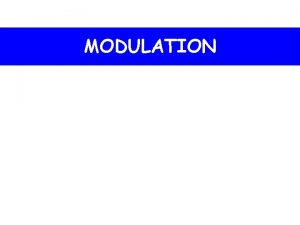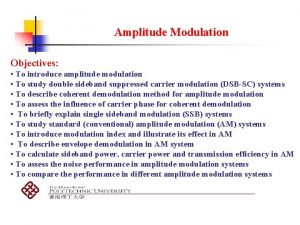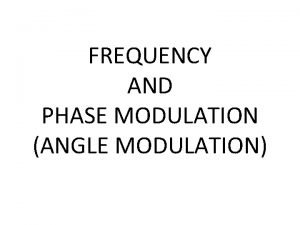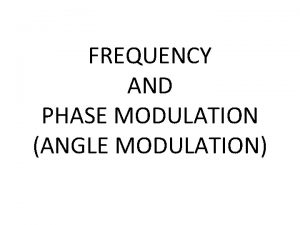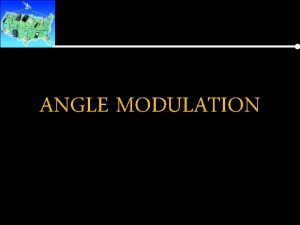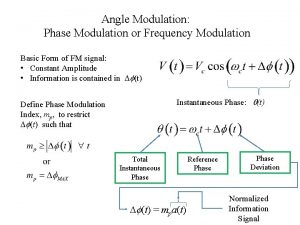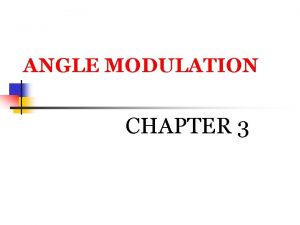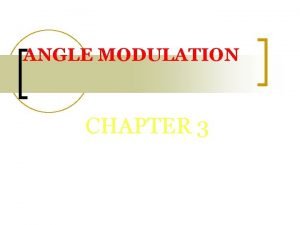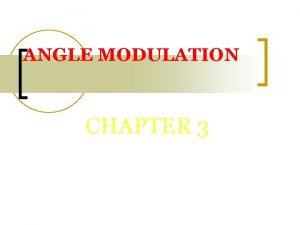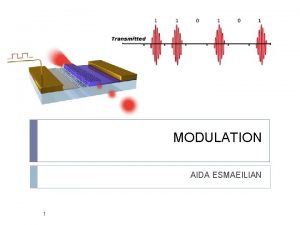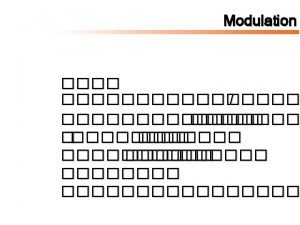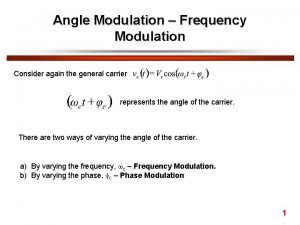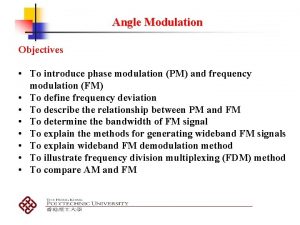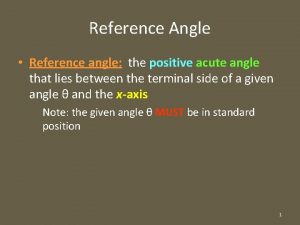ANGLE MODULATION EKT 343 Principle of Communication Engineering


























































































- Slides: 90

ANGLE MODULATION EKT 343 –Principle of Communication Engineering 1

Introduction �Angle modulation is the process by which the angle (frequency or phase) of the carrier signal is changed in accordance with the instantaneous amplitude of modulating or message signal. EKT 343 –Principle of Communication Engineering 2

Cont’d… �classified into two types such as ◦ Frequency modulation (FM) ◦ Phase modulation (PM) �Used ◦ ◦ ◦ for : Commercial radio broadcasting Television sound transmission Two way mobile radio Cellular radio Microwave and satellite communication system EKT 343 –Principle of Communication Engineering 3

Cont’d… Advantages over AM: ØFreedom from interference: all natural and external noise consist of amplitude variations, thus receiver usually cannot distinguish between amplitude of noise or desired signal. AM is noisy than FM. ØOperate in very high frequency band (VHF): 88 MHz-108 MHz ØCan transmit musical programs with higher degree of fidelity. EKT 343 –Principle of Communication Engineering 4

Principles of FM �A sine wave carrier can be modified for the purpose of transmitting information from one place to another by varying its frequency. This is known as frequency modulation (FM). �In FM, the carrier amplitude remains constant and the carrier frequency is changed by the modulating signal EKT 343 –Principle of Communication Engineering 5

Principles of FM �As the amplitude of the information signal varies, the carrier frequency shifts proportionately. �As the modulating signal amplitude increases, the carrier frequency increases. �With no modulation the carrier is at its normal center or resting frequency EKT 343 –Principle of Communication Engineering 6

Principles of FM �Frequency deviation (fd) is the amount of change in carrier frequency produced by the modulating signal. �The frequency deviation rate is how many times per second the carrier frequency deviates above or below its center frequency. �The frequency of the modulating signal determines the frequency deviation rate. �A type of modulation called frequencyshift keying (FSK) is used in transmission of binary data in digital cell phones and low-speed computer modems.

Principles of FM Carrier Modulating Signal FM signal EKT 343 –Principle of Communication Engineering 8

Carrier Resting fc Increasing fc Decreasing fc Increasing fc Resting fc Modulating signal FM

Principles of Phase Modulation �When the amount of phase shift of a constant-frequency carrier is varied in accordance with a modulating signal, the resulting output is a phase-modulation (PM) signal. �Phase modulators produce a phase shift which is a time separation between two sine waves of the same frequency. �The greater the amplitude of the modulating signal, the greater the phase shift.

Principles of Phase Modulation �The maximum frequency deviation produced by a phase modulator occurs during the time that the modulating signal is changing at its most rapid rate.

Principles of Phase Modulation Figure : A frequency shift occurs in PM only when the modulating signal amplitude varies. (a) Modulating signal. (b) FM signal. (c) PM signal.

Principles of Phase Modulation Relationship between the Modulating Signal and Carrier Deviation ◦ In FM and in PM, the frequency deviation is directly proportional to the amplitude of the modulating signal. ◦ In PM, the maximum amount of leading or lagging phase shift occurs at the peak amplitudes of the modulating signal. ◦ In PM the carrier deviation is proportional to both the modulating frequency and the amplitude.

Principles of Phase Modulation Figure: Frequency deviation as a function of (a) modulating signal amplitude and (b) modulating signal frequency.

Principles of Phase Modulation Converting PM into FM ◦ In order to make PM compatible with FM, the deviation produced by frequency variations in the modulating signal must be compensated for. ◦ This compensation can be accomplished by passing the intelligence signal through a lowpass RC network. ◦ This RC low-pass filter is called a frequencycorrecting network, predistorter, or 1/f filter and causes the higher modulating frequencies to be attenuated. ◦ The FM produced by a phase modulator is called indirect FM.

Principles of Phase Modulation Phase-Shift Keying ◦ The process of phase modulating a carrier with binary data is called phase-shift keying (PSK) or binary phase-shift keying (BPSK). ◦ The PSK signal has a constant frequency, but the phase of the signal from some reference changes as the binary modulating signal occurs.

Principles of Phase Modulation Figure: Phase modulation of a carrier by binary data produces PSK.

Mathematical analysis of FM �Mathematical analysis: �Let message signal: �And carrier signal: EKT 343 –Principle of Communication Engineering 18

Mathematical analysis of FM � During the process of frequency modulations the frequency of carrier signal is changed in accordance with the instantaneous amplitude of message signal. Therefore the frequency of carrier after modulation is written as �To find the instantaneous phase angle of modulated signal, integrate equation above w. r. t. t EKT 343 –Principle of Communication Engineering 19

Mathematical analysis of FM �Thus, we get the FM wave as: �Where modulation index for FM is given by EKT 343 –Principle of Communication Engineering 20

Mathematical analysis of FM �Therefore: � K 1 – deviation sensitivities Hz/V EKT 343 –Principle of Communication Engineering 21

Example 1 (FM) �Determine the peak frequency deviation (∆f) and modulation index (m) for an FM modulator with a deviation sensitivity K 1 = 5 k. Hz/V and a modulating signal, EKT 343 –Principle of Communication Engineering 22

Mathematical analysis of PM � The process by which changing the phase of carrier signal in accordance with the instantaneous of message signal. The amplitude remains constant after the modulation process. � Mathematical analysis: Let message signal: And carrier signal: EKT 343 –Principle of Communication Engineering 23

PM (cont’d) Where � = phase angle of carrier signal. It is changed in accordance with the amplitude of the message signal; �i. e. � After be phase modulation the instantaneous voltage will � or � Where mp = Modulation index of phase modulation � K is a constant and called deviation sensitivities of the phase EKT 343 –Principle of Communication Engineering 24

Example 2 (PM) �Determine the peak phase deviation (m) for a PM modulator with a deviation sensitivity K = 2. 5 rad/V and a modulating signal, EKT 343 –Principle of Communication Engineering 25

Summary of Mathematical Equation for FM and PM Tomasi Electronic Communications Systems, 5 e Copyright © 2004 by Pearson Education, Inc. Upper Saddle River, New Jersey 07458 All rights reserved. EKT 343 –Principle of Communication Engineering 26

Modulation Index and Sidebands �Any modulation process produces sidebands. �When a constant-frequency sine wave modulates a carrier, two side frequencies are produced. �Side frequencies are the sum and difference of the carrier and modulating frequency. �The bandwidth of an FM signal is usually much wider than that of an AM signal with the same modulating signal.

Modulation Index and Sidebands Modulation Index ◦ The ratio of the frequency deviation to the modulating frequency is known as the modulation index (mf). ◦ In most communication systems using FM, maximum limits are put on both the frequency deviation and the modulating frequency. ◦ In standard FM broadcasting, the maximum permitted frequency deviation is 75 k. Hz and the maximum permitted modulating frequency is 15 k. Hz. ◦ The modulation index for standard FM broadcasting is therefore 5.

Modulation Index and Sidebands Bessel Functions ◦ The equation that expresses the phase angle in terms of the sine wave modulating signal is solved with a complex mathematical process known as Bessel functions. ◦ Bessel coefficients are widely available and it is not necessary to memorize or calculate them.

FM&PM (Bessel function) �Thus, for general equation: EKT 343 –Principle of Communication Engineering 30

Bessel function EKT 343 –Principle of Communication Engineering 31

B. F. (cont’d) � It is seen that each pair of side band is preceded by J coefficients. The order of the coefficient is denoted by subscript m. The Bessel function can be written as � N = number of the side � Mf = modulation index frequency EKT 343 –Principle of Communication Engineering 32

Modulation Index and Sidebands Bessel Functions ◦ The symbol ! means factorial. This tells you to multiply all integers from 1 through the number to which the symbol is attached. (e. g. 5! Means 1 × 2 × 3 × 4 × 5 = 120) ◦ Narrowband FM (NBFM) is any FM system in which the modulation index is less than π/2 = 1. 57, or mf < π /2. ◦ NBFM is widely used in communication. It conserves spectrum space at the expense of the signal-to-noise ratio.

B. F. (cont’d) EKT 343 –Principle of Communication Engineering 34

Bessel Functions of the First Kind, Jn(m) for some value of modulation index EKT 343 –Principle of Communication Engineering 35

Representation of frequency spectrum EKT 343 –Principle of Communication Engineering 36

Example 3 �For an FM modulator with a modulation index m = 1, a modulating signal vm(t) = Vm sin(2π1000 t), and an unmodulated carrier vc(t) = 10 sin(2π500 kt). Determine the number of sets of significant side frequencies and their amplitudes. Then, draw the frequency spectrum showing their relative amplitudes. EKT 343 –Principle of Communication Engineering 37

Comparison NBFM&WBFM NBFM Modulation index greater than 10 less than 1 Freq deviation 75 k. Hz Modulation frequency 30 Hz- 15 k. HZ 3 k. Hz Spectrum Infinite no of sidebands and carrier Two sidebands and carrier Bandwidth 15 x NBFM 2(δ*fm (max)) 2 fm Noise More suppressed Less suppressed Application Entertainment & Broadcasting Mobile communication EKT 343 –Principle of Communication Engineering 38

FM Bandwidth � Theoretically, the generation and transmission of FM requires infinite bandwidth. Practically, FM system have finite bandwidth and they perform well. � The value of modulation index determine the number of sidebands that have the significant relative amplitudes � If n is the number of sideband pairs, and line of frequency spectrum are spaced by fm, thus, the bandwidth is: � For n≥ 1 EKT 343 –Principle of Communication Engineering 39

FM Bandwidth (cont’d) � Estimation of transmission b/w; � Assume mf is large and n is approximate � Bfm=2(mf + 2)fm mf + 2; thus = (1) is called Carson’s rule EKT 343 –Principle of Communication Engineering 40

Example 4 �For an FM modulator with a peak frequency deviation, Δf = 10 k. Hz, a modulating-signal frequency fm = 10 k. Hz, Vc = 10 V and a 500 k. Hz carrier, determine ◦ Actual minimum bandwidth from the Bessel function table. ◦ Approximate minimum bandwidth using Carson’s rule. ◦ Plot the output frequency spectrum for the Bessel approximation. EKT 343 –Principle of Communication Engineering 41

Deviation Ratio (DR) � The worse case modulation index which produces the widest output frequency spectrum. � Where ◦ ∆f(max) = max. peak frequency deviation ◦ fm(max) = max. modulating signal frequency EKT 343 –Principle of Communication Engineering 42

Example 5 �Determine the deviation ratio and bandwidth for the worst-case (widestbandwidth) modulation index for an FM broadcast-band transmitter with a maximum frequency deviation of 75 k. Hz and a maximum modulating-signal frequency of 15 k. Hz. �Determine the deviation ratio and maximum bandwidth for an equal modulation index with only half the peak frequency deviation and modulating-signal frequency. EKT 343 –Principle of Communication Engineering 43

Angle Modulation Part 2 n. Power distribution of FM n. Generation & Demodulation n. Noise in FM n. FM Threshold Effect n. Nonlinear Effect n. Application of FM EKT 343 –Principle of Communication Engineering 44

FM Power Distribution � As seen in Bessel function table, it shows that as the sideband relative amplitude increases, the carrier amplitude, J 0 decreases. � This is because, in FM, the total transmitted power is always constant and the total average power is equal to the unmodulated carrier power, that is the amplitude of the FM remains constant whether or not it is modulated. EKT 343 –Principle of Communication Engineering 45

FM Power Distribution (cont’d) � In effect, in FM, the total power that is originally in the carrier is redistributed between all components of the spectrum, in an amount determined by the modulation index, mf, and the corresponding Bessel functions. � At certain value of modulation index, the carrier component goes to zero, where in this condition, the power is carried by the sidebands only. EKT 343 –Principle of Communication Engineering 46

Average Power � The average power in unmodulated carrier � The total instantaneous power in the angle modulated carrier. � The total modulated power EKT 343 –Principle of Communication Engineering 47

Example 6 �For an FM modulator with a modulation index m = 1, a modulating signal vm(t) = Vmsin(2π1000 t) and an unmodulated carrier vc(t) = 10 sin(2π500 kt) Determine the unmodulated carrier power for the FM modulator given with a load resistance, RL = 50Ω. Determine also the total power in the anglemodulated wave. EKT 343 –Principle of Communication Engineering 48

Quiz � For an FM modulator with modulation index, m = 2, modulating signal, vm(t) = Vmcos(2π2000 t) and an unmodulated carrier, vc(t) = 10 cos(2π800 kt) Assume, RL=50Ω a) b) c) d) e) Determine the number of sets of significant sidebands. Determine their amplitudes. Draw the frequency spectrum showing the relative amplitudes of the side frequencies. Determine the bandwidth. Determine the total power of the modulated wave. EKT 343 –Principle of Communication Engineering 49

Generation of FM � Two major FM generation: i) Direct method: i) iii) iv) straight forward, requires a VCO whose oscillation frequency has linear dependence on applied voltage. Advantage: large frequency deviation Disadvantage: the carrier frequency tends to drift and must be stabilized. Common methods: i) ii) FM Reactance modulators Varactor diode modulators EKT 343 –Principle of Communication Engineering 50

Generation of FM (cont’d) 1) Reactance modulator EKT 343 –Principle of Communication Engineering 51

Generation of FM (cont’d) 2) Varactor diode modulator EKT 343 –Principle of Communication Engineering 52

Generation of FM (cont’d) ii) Indirect method: i. ii. Frequency-up conversion. Two ways: a. b. iii. Heterodyne method Multiplication method One most popular indirect method is the Armstrong modulator EKT 343 –Principle of Communication Engineering 53

Wideband Armstrong Modulator EKT 343 –Principle of Communication Engineering 54

Armstrong Modulator A complete Armstrong modulator is supposed to provide a 75 k. Hz frequency deviation. It uses a balanced modulator and 90 o phase shifter to phasemodulate a crystal oscillator. Required deviation is obtained by combination of multipliers and mixing, raise the signal from suitable for broadcasting. EKT 343 –Principle of Communication Engineering 55

Generation of FM and PM EKT 343 –Principle of Communication Engineering 56

FM Detection/Demodulation � FM demodulation ◦ is a process of getting back or regenerate the original modulating signal from the modulated FM signal. ◦ It can be achieved by converting the frequency deviation of FM signal to the variation of equivalent voltage. ◦ The demodulator will produce an output where its instantaneous amplitude is proportional to the instantaneous frequency of the input FM signal. EKT 343 –Principle of Communication Engineering 57

FM detection (cont’d) � To detect an FM signal, it is necessary to have a circuit whose output voltage varies linearly with the frequency of the input signal. � The most commonly used demodulator is the PLL demodulator. Can be use to detect either NBFM or WBFM. EKT 343 –Principle of Communication Engineering 58

PLL Demodulator V 0(t) fi FM input Phase detector Low pass filter Amplifier fvco VCO Vc(t) EKT 343 –Principle of Communication Engineering 59

PLL Demodulator � The phase detector produces an average output voltage that is linear function of the phase difference between the two input signals. Then low frequency component is pass through the LPF to get a small dc average voltage to the amplifier. � After amplification, part of the signal is fed back through VCO where it results in frequency modulation of the VCO frequency. When the loop is in lock, the VCO frequency follows or tracks the incoming frequency. EKT 343 –Principle of Communication Engineering 60

PLL Demodulator �Let instantaneous freq of FM Input, fi(t)=fc +k 1 vm(t), and the VCO output frequency, f VCO(t)=f 0 + k 2 Vc(t); f 0 is the free running frequency. �For the VCO frequency to track the instantaneous incoming frequency, fvco = fi; EKT 343 –Principle of Communication Engineering 61

PLL Demodulator � f 0 + k 2 Vc(t)= fc +k 1 vm(t), so, � If VCO can be tuned so that fc=f 0, then � Where Vc(t) is also taken as the output voltage, which therefore is the demodulated output EKT 343 –Principle of Communication Engineering 62

Noise in FM �Noise is interference generated by lightning, motors, automotive ignition systems, and power line switching that produces transient signals. �Noise is typically narrow spikes of voltage with high frequencies. �Noise (voltage spikes) add to a signal and interfere with it. �Some noise completely obliterates signal information. EKT 343 –Principle of Communication Engineering 63

Noise in FM �In AM systems, noise easily distorts the transmitted signal however, in FM systems any added noise must create a frequency deviation in order to be perceptible. θ EKT 343 –Principle of Communication Engineering 64

Noise in FM(Cont’d) � The maximum frequency deviation due to random noise occurs when the noise is at right angles to the resultant signal. In the worst case the signal frequency has been deviated by: δ = θfm � This shows that the deviation due to noise increases as the modulation frequency increases. Since noise power is the square of the noise voltage, the signal to noise ratio can significantly degrade. � Noise occurs predominantly at the highest frequencies within the baseband EKT 343 –Principle of Communication Engineering 65

Noise-Suppression Effects of FM �FM signals have a constant modulated carrier amplitude. �FM receivers contain limiter circuits that deliberately restrict the amplitude of the received signal. �Any amplitude variations occurring on the FM signal are effectively clipped by limiter circuits. �This amplitude clipping does not affect the information content of the FM signal, since it is contained solely within the frequency variations of the carrier. EKT 343 –Principle of Communication Engineering 66

Noise-Suppression Effects of FM Figure 5 -11: An FM signal with noise. EKT 343 –Principle of Communication Engineering 67

Noise-Suppression Effects of FM Preemphasis ◦ Noise can interfere with an FM signal and particularly with the high-frequency components of the modulating signal. ◦ Noise is primarily sharp spikes of energy and contains a lot of harmonics and other highfrequency components. ◦ To overcome high-frequency noise, a technique known as preemphasis is used. ◦ A simple high-pass filter can serve as a transmitter’s pre-emphasis circuit. ◦ Pre-emphasis provides more amplification of only high-frequency components. EKT 343 –Principle of Communication Engineering 68

Noise-Suppression Effects of FM Preemphasis circuit. EKT 343 –Principle of Communication Engineering 69

Noise-Suppression Effects of FM Preemphasis ◦ A simple low-pass filter can operate as a deemphasis circuit in a receiver. ◦ A deemphasis circuit returns the frequency response to its normal flat level. ◦ The combined effect of preemphasis and deemphasis is to increase the signal-tonoise ratio for the high-frequency components during transmission so that they will be stronger and not masked by noise. EKT 343 –Principle of Communication Engineering 70

Noise-Suppression Effects of FM Deemphasis circuit. EKT 343 –Principle of Communication Engineering 71

FM threshold effect � In FM systems where the signal level is well above noise received carrier-to-noise ratio and demodulated signal-tonoise ratio are related by: = signal-to-noise ratio at output of FM demodulator = modulation index = carrier-to-noise ratio at input of FM demodulator � Does not apply when the carrier-to-noise ratio decreases below a certain point. Below this critical point the signal-tonoise ratio decreases significantly. � Known as the FM threshold effect EKT 343 –Principle of Communication Engineering 72

� Below the FM threshold point the noise signal (whose amplitude and phase are randomly varying), may instantaneously have an amplitude greater than that of the wanted signal. � When this happens the noise will produce a sudden change in the phase of the FM demodulator output. • In an audio system this sudden phase change makes a "click". In video, the term "click noise" is used to describe short horizontal black and white lines that appear randomly over a picture. EKT 343 –Principle of Communication Engineering 73

Nonlinear Effect in FM 1. Strong nonlinearity; intentionally introduced in a controlled manner. It is introduced for particular application e. g. square law modulators, hardlimiters and frequency multipliers. 2. Weak nonlinearity; introduced because of imperfections in the communication channel. Such linearities reduce the useful signal levels. � In next slide, we will examine the effects of weak nonlinearities on FM signal EKT 343 –Principle of Communication Engineering 74

Transfer characteristic of communication channel is given by Where We know that EKT 343 –Principle of Communication Engineering 75

� After filtering through bandpass filter, the fm signal output � Effect of nonlinearities: nonlinear nature of channel changes the amplitudes of the FM signal EKT 343 –Principle of Communication Engineering 76

Application of FM � FM is commonly used at VHF radio frequencies for high-fidelity broadcasts of music and speech (FM broadcasting). Normal (analog) TV sound is also broadcast using FM. The type of FM used in broadcast is generally called wide-FM, or W-FM �A narrowband form is used for voice communications in commercial and amateur radio settings. In two-way radio, narrowband narrow-fm (N-FM) is used to conserve bandwidth. In addition, it is used to send signals into space. EKT 343 –Principle of Communication Engineering 77

Frequency Modulation Versus Amplitude Modulation Major applications of AM and FM

Advantages � Wideband FM gives significant improvement in the SNR at the output of the RX which proportional to the square of modulation index. � Angle modulation is resistant to propagation-induced selective fading since amplitude variations are unimportant and are removed at the receiver using a limiting circuit. � Angle modulation is very effective in rejecting interference. (minimizes the effect of noise). � Angle modulation allows the use of more efficient transmitter power in information. � Angle modulation is capable of handing a greater dynamic range of modulating signal without distortion than AM. EKT 343 –Principle of Communication Engineering 79

Disadvantages �Angle modulation requires a transmission bandwidth much larger than the message signal bandwidth. �Angle modulation requires more complex and expensive circuits than AM. EKT 343 –Principle of Communication Engineering 80

Summary of angle modulation -what you need to be familiar with EKT 343 –Principle of Communication Engineering 81

Summary (cont’d) EKT 343 –Principle of Communication Engineering 82

Summary (cont’d) � a) b) Bandwidth: Actual minimum bandwidth from Bessel table: Approximate minimum bandwidth using Carson’s rule: EKT 343 –Principle of Communication Engineering 83

Summary (cont’d) Multitone modulation (equation in general): � EKT 343 –Principle of Communication Engineering 84

Summary (cont’d) EKT 343 –Principle of Communication Engineering 85

END OF ANGLE MODULATION EKT 343 –Principle of Communication Engineering 86

Exercise 1 �Determine the deviation ratio and worst-case bandwidth for an FM signal with a maximum frequency deviation 25 k. Hz and maximum modulating signal 12. 5 k. Hz. EKT 343 –Principle of Communication Engineering 87

Exercise 2 �For an FM modulator with 40 -k. Hz frequency deviation and a modulatingsignal frequency 10 k. Hz, determine the bandwidth using both Carson’s rule and Bessel table. EKT 343 –Principle of Communication Engineering 88

Exercise 3 �For an FM modulator with an unmodulated carrier amplitude 20 V, a modulation index, m = 1, and a load resistance of 10 -ohm, determine the power in the modulated carrier and each side frequency, and sketch the power spectrum for the modulated wave. EKT 343 –Principle of Communication Engineering 89

Exercise 4 �A frequency modulated signal (FM) has the following expression: The frequency deviation allowed in this system is 75 k. Hz. Calculate the: ◦ Modulation index ◦ Bandwidth required, using Carson’s rule EKT 343 –Principle of Communication Engineering 90
 Advantages of angle modulation
Advantages of angle modulation Microwave optics
Microwave optics Kalkulationsberechnung
Kalkulationsberechnung Amplitude modulation vs frequency modulation
Amplitude modulation vs frequency modulation Amplitude modulation vs frequency modulation
Amplitude modulation vs frequency modulation Angle modulation formula
Angle modulation formula Principle of amplitude modulation
Principle of amplitude modulation Communication engineering
Communication engineering Csc 343
Csc 343 Texas health and safety code 343
Texas health and safety code 343 Experiment 343
Experiment 343 Experiment 343
Experiment 343 Soen 343
Soen 343 Cecs 343
Cecs 343 Soen 343
Soen 343 Descompunerea lui 343
Descompunerea lui 343 X3=64/343
X3=64/343 Cs 343
Cs 343 343 day
343 day Log 343
Log 343 343*15
343*15 343 jesus
343 jesus Soen 343
Soen 343 Opwekking 343 tekst
Opwekking 343 tekst Soen 343
Soen 343 582 x 4
582 x 4 Opkins
Opkins Csc 343
Csc 343 Factoring internacional
Factoring internacional Sss similarity theorem
Sss similarity theorem Critical angle formula
Critical angle formula Difference between 1st and 3rd angle projection
Difference between 1st and 3rd angle projection What is an angle whose vertex is the center of the circle
What is an angle whose vertex is the center of the circle Site:slidetodoc.com
Site:slidetodoc.com Absolute angle vs relative angle
Absolute angle vs relative angle Vertical angles
Vertical angles Name an angle adjacent to angle fgi
Name an angle adjacent to angle fgi Angle klm and angle mln are linear pair
Angle klm and angle mln are linear pair Bisectors worksheet
Bisectors worksheet Angle addition practice answer key
Angle addition practice answer key Extinction in minerals
Extinction in minerals 43⁰
43⁰ Drilling definition
Drilling definition John wants to measure the height of a tree
John wants to measure the height of a tree What is the measure of angle 2?
What is the measure of angle 2? Sas postulate proof
Sas postulate proof Lesson 4 measuring angles
Lesson 4 measuring angles First angle projection and third angle projection
First angle projection and third angle projection Linear measurement devices
Linear measurement devices Advantages of digital modulation
Advantages of digital modulation Oblique translation techniques
Oblique translation techniques Tina champagne sensory modulation and environment
Tina champagne sensory modulation and environment Trail edge modulation
Trail edge modulation Pulse code modulation
Pulse code modulation Percent modulation formula
Percent modulation formula Modulation error ratio
Modulation error ratio Modulation digital to analog
Modulation digital to analog Demodulation process
Demodulation process Optimaler beschleunigungsweg beispiele
Optimaler beschleunigungsweg beispiele Disadvantages of fsk
Disadvantages of fsk Onu
Onu Direct modulation
Direct modulation Modulation coding scheme
Modulation coding scheme Fragmentation corollary example
Fragmentation corollary example Ask modulation constellation diagram
Ask modulation constellation diagram Cross modulation
Cross modulation Ask modulation constellation diagram
Ask modulation constellation diagram Dscfc
Dscfc Thermal noise in analog communication
Thermal noise in analog communication Demodulation of delta modulation
Demodulation of delta modulation Ask modulation constellation diagram
Ask modulation constellation diagram Rf circuit design ppt
Rf circuit design ppt Formula for modulation index
Formula for modulation index Monophonic modulation
Monophonic modulation Formula for modulation index
Formula for modulation index Modulacion
Modulacion What is the modulation of severn suzuki speech
What is the modulation of severn suzuki speech Pwm advantages
Pwm advantages Pulse width modulation ppt
Pulse width modulation ppt Pulse code modulation and demodulation
Pulse code modulation and demodulation Pulse code modulation and demodulation
Pulse code modulation and demodulation Calculate quantization error
Calculate quantization error Rfid modulation techniques
Rfid modulation techniques Significance of modulation index
Significance of modulation index Ads b modulation
Ads b modulation Disadvantages of digital modulation
Disadvantages of digital modulation Frequency shift keying modulation
Frequency shift keying modulation Disadvantages of pam
Disadvantages of pam Brian siller
Brian siller Source modulation in aas
Source modulation in aas Envelop
Envelop

